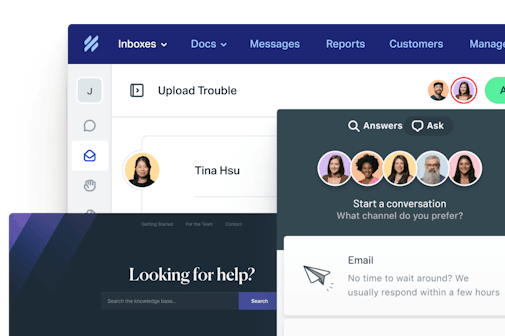
9 Example Customer Service Goals for Your 2025 Strategy
I’ve always been a goal-driven person. When hiking, I look for the next mile marker and search for signs that I’m nearing the summit. Whoever said that the journey is the destination must never have felt the satisfaction of achieving their goals.
I kid, of course: Even when you don’t achieve 100% of your goals, the process of setting them and working toward them offers tangible benefits.
Customer service goals are no exception. There is no better way to deliver consistently great customer service and challenge your team members to grow than by setting smart goals.
Below, we offer a framework for setting effective customer service goals and share nine SMART goals you can put into practice right now to improve your customer experience.
Why you need customer service goals
Taking the time to set goals for your team and for yourself is like taking the time to check the map: You’ll know where you're heading, and you’ll be much more likely to get there.
Goals give your team direction and focus. This can lead to more independence; when everyone knows the plan, they can make their own decisions and act more autonomously.
Goals help manage team performance. Stated goals help facilitate feedback opportunities and provide a benchmark for agents to measure themselves against.
Goals align everyone’s actions. Everyone from agents to managers to the entire team can work together for the company’s success. By showing how individual actions generate success for the business, goals motivate action.
Goals gradually improve your customer service. By drawing attention to areas of opportunity, you ensure that everyone on your team is thinking about improving the same thing. A boat moves faster when everyone is rowing in the same direction!
How to set effective goals for your team
Not all goals are created equally. In order for them to be motivating, they need to follow the SMART philosophy:
Specific
Measurable
Achievable
Relevant
Time-bound
Keeping your goals specific and measurable will help you understand when you’ve met them, and keeping them achievable will ensure that your team remains motivated to strive for them.
For example, you could say that you want to achieve 100% customer satisfaction on all tickets in 2025. While it’s specific and measurable, it’s not achievable. As soon as that first bad satisfaction response comes in, your team members will feel like they've failed.
Unattainable goals usually look really good on paper, but they don’t actually foster better customer service. A specific, measurable, and achievable goal might be that you want a 20% increase in customer satisfaction in 2025.
Relevant goals align with your organization’s mission and may connect to larger company goals. Making your goals time-bound (i.e., setting a time limit within which they'll be achieved) will help you evaluate your progress and encourage momentum.
SMART goals for customer service are an easy framework to use to ensure that your goals meet all of the requirements to be the most effective.
9 example customer service goals
Customer service goals should be directly related to the goals of the wider organization. They should be easily trackable and frequently discussed within the team. Every individual can contribute to these goals, and ensuring the entire team is on board is crucial to achieving them.
Below, you'll find nine example customer service goals, each in SMART goal format.
1. Increase customer satisfaction from 82% to 87% in the next three months
Most, if not all, customer service teams will use customer satisfaction (CSAT) as one of their key performance indicators (KPIs). After all, if your customers are not satisfied with your service, it’s time to change what you’re doing.
Setting customer satisfaction goals puts your team’s focus on providing a consistently great customer service experience. This feeds back into the customer experience as a whole.
Most customer service software offer customer satisfaction survey features that make it easy to measure your CSAT scores overall and during specific timeframes.
2. Increase quarterly NPS from 80 to 90 before the end of Q4
While CSAT represents the customer’s reaction to the support that your team provides, net promoter score (NPS) reflects their overall relationship with your brand. Although customer service is just a small piece of your brand as a whole, it has an outsized impact.
Like CSAT, when you set a goal to improve NPS, it does the heavy lifting of refocusing your entire team. Not only does NPS light a fire under your customer service team, it also reflects the work of the company as a whole.
Including NPS as part of your customer service strategy is an excellent complement to other work that your team is currently doing, such as lowering response times or implementing a new social media service channel.
As you work toward other goals, you are also able to measure the correlative impact that they have. For instance, when you work to improve response times, you notice an increase in NPS. This type of correlation gives you good data for what you might use for future goals, too.
3. Decrease average first reply time for email from 11 hours to 8 hours by October 31st
In the mission to provide great customer service, speed is your best friend. Customers consistently rate quick answers as a crucial aspect of their customer service experience.
Responding quickly is a full team goal. Not only do agents have to be focused and treat customer conversations with urgency, but they also need to be supported with the right tools and properly staffed.
There are many ways to measure customer wait times, depending on the experience you want to provide over different channels. For phone support, you may measure the amount of time customers spend on hold. For email, social media, and chat, you could measure the time to first reply or total resolution time.
To measure first reply time (FRT), look at the amount of time that passes from when the customer first contacts you until they get their first human response. FRT is calculated as an average across all tickets.
4. Reduce cost per contact by 10% for free plan users by the end of Q1
If you had an unlimited budget, reducing customer wait times and increasing customer satisfaction would be straightforward — just hire more people and give all of your customers a puppy! Unfortunately, you always need to balance your desire to grow the team with your budget restrictions.
Reducing the cost of supporting customers (while keeping quality high!) is an important business goal and something the entire customer service team can contribute to.
If it costs more to support your customers than they are paying you, your business will not be profitable. However, if your customers pay you well and you provide crummy support, your customer experience will suffer and your customers may move elsewhere.
To measure cost per contact (CPC), divide the total cost of providing support (labor, tools, and other costs) by the number of contacts received. You can segment this calculation by a number of different criteria, including the contact channel and the type of users.
CPC is impacted by a number of things. To reduce CPC, you can try to direct customers to lower effort channels (for example, chat and social media are more cost-effective than phone support), create more self-service opportunities (via a knowledge base or AI agent), or become more efficient at answering tickets.
5. Reply to 50 social media support requests by the end of the year
If you want to set up a goal around launching a new support channel, you might be tempted to make the goal something like "Launch social support by the end of the year." However, that goal wouldn't fit into the SMART framework because it's not specific enough. What does it mean to launch social media support?
Instead, you can create SMART goals that support getting the channel set up. For example, to respond to 50 social media support requests, you'll need a way to receive those requests, a team to respond to them, and a tool to track responses. However, you might not need to have everything set up 100% ideally to start delivering social support.
By setting a goal for the number of requests to respond to, your team will be motivated to find ways to deliver social support in a way that helps you learn as you go.
6. Increase average quality score from 3.5 to 4.2 by the end of January
Getting the right answer to a customer the first time is a primary driver of good customer service. To monitor the quality of your team’s replies, consider implementing quality assurance or conversation reviews. Providing ongoing feedback through reviews can ensure that your entire team is delivering excellent customer service.
To measure quality, you first need to define what quality means to you. What kind of tone do you use? Do agents need to provide additional resources in their responses? For this goal specifically, you'll need a quality assurance rubric you can use to measure your quality score.
Once the rubric has been developed, you can grade a random selection of conversations to determine your quality score. Taking the time to provide feedback on each review will help your agents know what they can do to improve their own quality, thus boosting the team’s quality (and your customer experience) as well.
7. Increase my average quality score from 2.4 to 4 by December 31st
To hit certain team-level goals, you'll need to create individual goals as well. For example, if you want to increase your team's average quality score, you might also want to have your agents set individual goals to increase their own quality scores.
8. Increase employee NPS by 20% between the September and December employee surveys
Happy employees equal happy customers. Or, at the very least, unhappy employees will make it a lot harder to provide empathetic, thoughtful service to your customers. Improving the experience of your customer service team should be a top priority for all support managers.
Measuring agent happiness can take a number of different forms. One of the most direct ways is to just ask your agents how they feel.
Employee NPS uses the same question as net promoter score to ask employees how likely they are to recommend your company as a place to work. This survey can also provide some qualitative feedback on what you’ll need to do to accomplish your goal.
Alternatively, you can measure agent happiness by looking at employee churn and retention rates. If agents are staying around for longer, they are likely happier.
9. Resolve 30% of customer issues automatically in Q3
If your team is planning on adopting AI into your support process, having a goal for the AI can help you take the necessary steps to get it up and running, replying to, and satisfying customers.
To answer customers' questions automatically, you're going to need the right tools, you may need to spend some time training the AI, and you'll definitely want to monitor the quality of the responses it's giving for a while to make sure it's providing the same level of support you expect from your team.
You can also set goals to help you focus on improving your AI support over time, such as "Increase CSAT for AI-generated responses to 80% in Q4." Hitting this goal may mean spending more time training the AI, creating more knowledge base articles, or updating help center articles or website pages that are out of date.
Setting other types of goals for your support team
While the example goals above are all focused on ways you can deliver better support, you may also need to set goals that help your team expand their skill sets and develop their careers. For example, if an individual contributor expresses a desire to move into a management role, you'll want to set goals to help them get ready for that opportunity.
Even more nebulous goals like this can be transformed into SMART goals. For example: "I will lead two product training meetings in Q4 and meet with my manager for feedback on those sessions." This gives the employee specific actions they can take and gives you a specific way to measure the results when it's time for performance reviews.
Setting SMART goals will keep your team moving forward both in their careers and in your efforts to deliver ever-better support to your customers. By following this framework for everything you and your team want to accomplish, you can set yourselves up for success and learn from your efforts even when you miss the mark.








